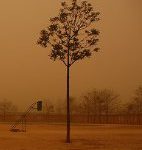The United Nations has declared 2006 as the International Year of Deserts and Desertification, in recognition of the grave perils of desertification, a global phenomenon affecting a third of the earth’s surface and more than one billion people in over 100 countries. As susceptible dryland areas lose their productive capacity, says the UN, desertification has potentially devastating social and economic consequences, including poverty, famine and political instability.
Acknowledging those connections, the UN Convention to Combat Desertification was established after the 1992 Earth Summit in Rio de Janeiro. The convention defined desertification as “land degradation in arid, semi-arid and dry sub-humid areas resulting from various factors, including climatic variations and human activities”, and is the first international treaty to address the issues of poverty and environmental degradation in rural areas. It also is the first pact, says the UN, to “recognise that grassroots resource-users are central to identifying and implementing solutions”; to involve local women as well as men in the development process; to stress the need for an integrated approach, and to call for a global mechanism to mobilise resources through partnerships. (At the 2002 World Summit on Sustainable Development, the convention was singled out as a key instrument for poverty eradication in dryland rural areas.)
In establishing the International Year, the UN General Assembly emphasised concern over desertification and its implications for the UN’s eight Millennium Development Goals, to be met by 2015. One of those goals is ensuring environmental stability. That involves integrating the principles of sustainable development into country policies and programmes; reversing the loss of environmental resources; reducing by 50 percent the proportion of people without sustainable access to safe drinking water; and, by 2020, achieving significant improvement in the lives of at least 100 million slum-dwellers.
China is on the frontline in the struggle with desertification. The country’s grasslands have been severely damaged and its soil eroded by overgrazing of livestock, drought, mining and other types of development. Also contributing to the worsening desertification situation is deforestation – the conversion of forested areas to non-forested ones, whether deliberately (such is by logging, agriculture or dam construction) or unintended (such is through catastrophic wildfires). Tree roots are essential for keeping topsoil in place; without them, soil erosion and flooding inevitably result.
In China, the problems are acknowledged as immense. For example, “the deterioration of the plant cover in the headwaters of the Yangtze river has created major flooding problems,” according to the UN Environment Programme’s Global Deserts Outlook. “Massive efforts are now required to deal with the enormous problem of water erosion in the Loess Plateau, one of the most eroded regions in the world, on account of intensive agricultural practices on the steep mountain slopes.” The plateau is situated between the deserts of western China and the north China plain. As a result of the deterioration of water reserves, it has become essential to monitor groundwater levels and confront salinity problems on the vast plain.
On the Qinghai-Tibet plateau (“the roof of the world”), glaciers are shrinking by 7% a year because of climate change, the news agency Xinhua reported in May 2006. Dong Guangrong of the Chinese Academy of Sciences told the agency that as the glaciers retreat due to global warming, the high plateau is turning to desert – which will trigger more droughts and sandstorms. Dong’s study used more than 40 years’ worth of data from nearly 681 Chinese weather stations. Average temperatures in Tibet have risen by 0.9 degrees C. since the 1980s, causing the glaciers to melt faster, Han Yongxiang of the National Meteorological Bureau told Xinhua.
Since February 2006, Beijing has sustained the worst sandstorm record in five years. Through a combination of forces, the Gobi desert is expanding by about 950 square miles annually, drawing ever closer to the capital. China is battling to stem the sandy tide through a decades-long programme to shield the city through the creation of a series of greenbelts. Popularly termed “the Green Great Wall”, the government plans an eventual 2,800-mile network of forest belts, containing billions of trees, to stop the advancing desert, much like the Great Wall was erected centuries ago to keep out unwelcome invaders.
Some 2.64 million square kilometres of land in China has already been devoured by desertification – nearly one-third of its landmass, the government says. Zhu Lieke, deputy director of the State Forestry Administration, reported some progress, however, telling the Beijing International Conference on Women and Desertification in May 2006 that China’s deserts are shrinking by 7,585 square kilometres annually, compared with yearly expansion of 10,400 square kilometres at the end of the 20th century.
Others are not so optimistic. The leading environmentalist Lester Brown of the Washington-based Earth Policy Institute, says a giant dust bowl is forming across northern China and that it “represents the largest conversion of productive land to desert anywhere in the world … Here and there, there are successful pilot projects, but overall we are not anywhere close to arresting this situation. The deserts are expanding.” In past years, says Brown, dust from storms originating in China has been traced all the way to the United States and Canada.
San Francisco-based Pacific Environment — which works to protect the living environment of the Pacific Rim by promoting grassroots activism, strengthening communities and reforming international policies – is also worried about the larger picture. “The inability of China’s farmers to eke out a crop from drying land,” the organisation points out, “will force it to turn to the world food market, further intensifying the stresses on land in grain-producing countries like the US and Canada.”
Zhu acknowledges that the work China needs to do on desertification “remains tough” and, despite a yearly investment of 2 billion yuan (US $250 million), restoring all the country’s “curable” desertified land – 530,000 square kilometres — by 2050 will be difficult. To reach that goal, he said, would cost at least 238.5 yuan (US$29.8 billion).
The government, Zhu said, has been hampered by a shortage to funds with which to confront desertification, which, he added, affects the lives of 400 million people and causes direct economic losses of 54 billion yuan (US $6.75 billion) annually. Zhu noted that overgrazing of livestock (which has greatly increased in China since the late 1970s), overlogging, collection of firewood and other human activities still were taking place in environmentally fragile areas, and global warming could worsen the trend toward desertification. The battle needs to be fought, Zhu said, by improving legislation, by severely punishing those who damage the environment and by strengthening international cooperation.
Yang Weixi, the chief engineer of China’s Desertification Control Centre, told the Los Angeles Times in April 2006 that the millions of square kilometres of desert in China “will continue to be a source of sandstorms in the future, and we cannot cherish unrealistic expectations this problem will vanish overnight.”
In one week in April, desert winds dumped 300,000 tons of sand and dust on Beijing, turning rooftops yellow and forcing residents to wear surgical masks. Meanwhile, in southern China, floods and mudslides – triggered by torrential rains and exacerbated in some cases by deforestation – have claimed lives and forced a great number of people to flee their homes. Over the past 40 years, Chinese meteorological studies indicate, the country has experienced rising temperatures. “Experts project that the ‘northern drought, southern flood’ weather pattern will break by 2015, as less precipitation falls in the rainy reaches of the Yangtze river and more comes to northern China,” says the Worldwatch Institute. But it adds a cautionary – and worrying — note: “Such projections could change, however, as human activities increasingly affect the global climate.”





